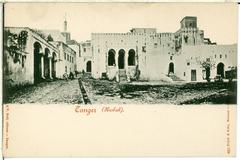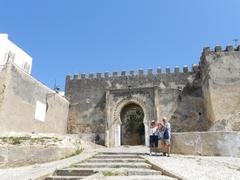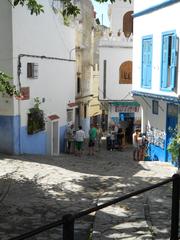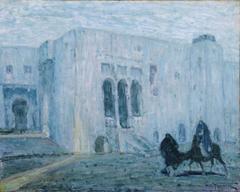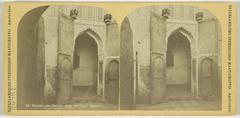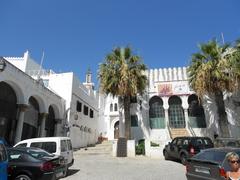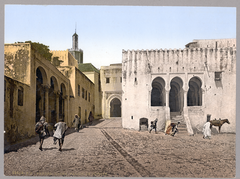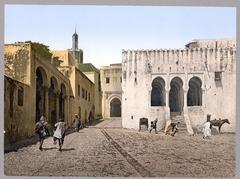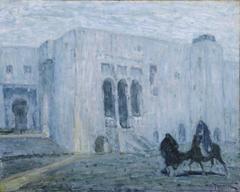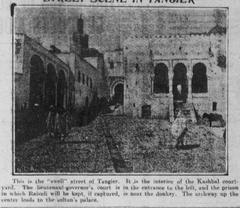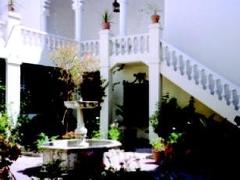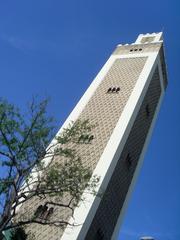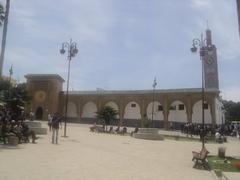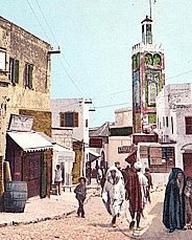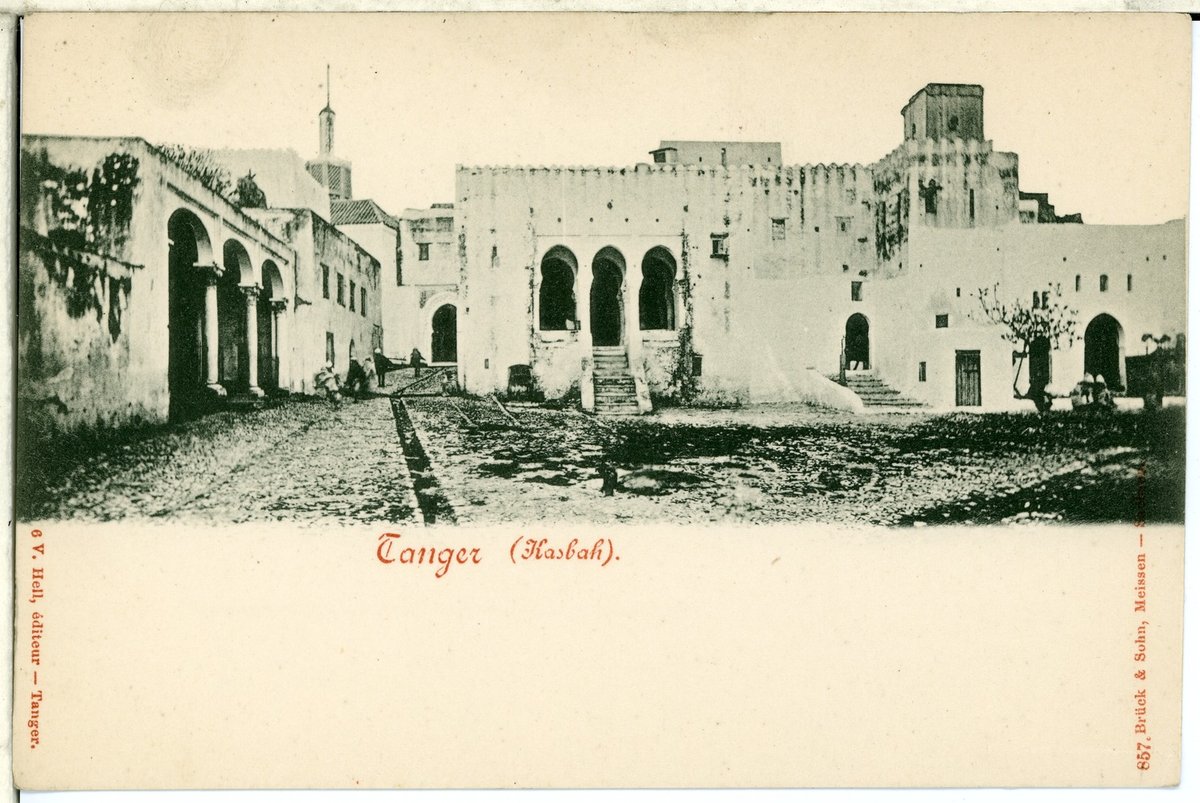
Dar El Makhzen Tangier: Visiting Hours, Tickets, and Historical Significance
Date: 15/06/2025
Introduction
Dar El Makhzen, also known as the Kasbah Palace or Sultan’s Palace, is an architectural and historical jewel at the heart of Tangier’s Kasbah district. Perched atop the city’s highest point, this former royal residence offers breathtaking views over the Strait of Gibraltar and the Tangier medina, while encapsulating centuries of Moroccan royal heritage, Mediterranean cross-cultural exchange, and artistic splendor. Today, Dar El Makhzen operates as the Kasbah Museum of Mediterranean Cultures, inviting visitors to discover Tangier’s layered history through its stunning palatial architecture and diverse museum collections (Wikipedia; Morocco Guide).
Historical Overview
Early Foundations and Strategic Importance
The site of Dar El Makhzen has long held strategic importance, with its earliest fortifications dating to the 15th century under Portuguese control, followed by English occupation in the 17th century. Its elevated position allowed for both defense and the monitoring of maritime activity across the Strait of Gibraltar, establishing Tangier as a vital gateway between Africa and Europe (Wikipedia; Morocco Guide).
Transformation into the Sultan’s Palace
The palace as it stands today was commissioned in the early 18th century by Sultan Moulay Ismail, who sought to assert Moroccan sovereignty and architectural grandeur following the English withdrawal. Built atop the former “Upper Castle,” the palace incorporated Moroccan, Andalusian, and European influences, with elegant courtyards, marble fountains, and finely carved cedar ceilings (Barcelo Guide; Lonely Planet).
Evolution and Museum Conversion
Over the centuries, Dar El Makhzen expanded and evolved, serving as a residence for visiting sultans and Moroccan governors, and remaining a symbol of national identity even as Tangier experienced periods of international governance. In 1922, the palace began its transformation into a museum, and after extensive renovations, it reopened as the Kasbah Museum of Mediterranean Cultures. The museum’s collections now span prehistoric times to the present, highlighting Tangier’s diverse and cosmopolitan heritage (The Right Voyage; Tour Travel World).
Architectural and Artistic Highlights
Dar El Makhzen’s design features two main courtyards adorned with marble fountains, zellij tilework, and lush Andalusian gardens. The palace’s dependencies include a former treasury and prison, now home to contemporary art exhibitions. Notable artifacts inside include Roman mosaics (notably Venus from Volubilis), Islamic manuscripts, traditional Moroccan firearms, and intricate textiles and ceramics (Morocco.com; The Right Voyage).
Key architectural elements:
- Zellij Tilework: Intricate geometric mosaics throughout floors, walls, and fountains.
- Carved Cedar Ceilings: Painted and gilded woodwork sourced from the Middle Atlas.
- Stucco Decoration: Elaborate floral and calligraphic plaster designs.
- Horseshoe Arches: Signature of Moorish and Andalusian design.
- Defensive Features: Thick stone walls and strategic vantage points reflecting the site’s original military purpose (Atlas Obscura).
Visitor Information
Visiting Hours
- Dar El Makhzen / Kasbah Museum:
Generally open daily except Tuesday, from 10:00 AM to 6:00 PM (last entry 5:30 PM).
Hours may vary on public holidays—check official sources before your visit (Tour Travel World).
Tickets and Admission
- Entry Fee: Around 25–30 MAD (€2.40), including access to the contemporary art museum.
- Guided Tours: Available in multiple languages for 150–300 MAD; these offer deeper context and highlight key collections (Morocco Magics).
- Payment: Bring cash, as card payments may not always be accepted.
Accessibility
- Most main areas are accessible, but expect some uneven flooring and narrow stairways typical of historic sites. Staff assistance is available for visitors with mobility challenges (Morocco Magics).
Practical Tips
- Best Times to Visit: Early morning or late afternoon, especially during October–April for cooler weather and fewer crowds.
- Dress Code: Modest attire is recommended.
- Amenities: Restrooms and a planned café; nearby options like Salon Bleu provide refreshments and views.
- Photography: Allowed in most areas, except where signage restricts it. Flash and tripods are generally prohibited to protect the artworks.
Museum Experience
Exhibits at the Kasbah Museum chronicle Tangier’s history from prehistoric times through Phoenician, Roman, Islamic, and European eras. Highlights include:
- Archaeological finds: Phoenician urns, Roman mosaics, and ancient ceramics.
- Art and crafts: Textiles, jewelry, musical instruments, and weaponry.
- Historical documents: Maps, manuscripts, and ethnographic displays.
- Temporary exhibitions: Showcasing contemporary Mediterranean cultures (Tour Travel World).
Most signage is in Arabic and French; English-speaking guides are available and recommended (Art and Then Some).
Family-Friendliness and Safety
The palace’s spacious courtyards and interactive exhibits are family-friendly, and staff are welcoming to visitors of all ages. The surrounding Kasbah is safe, with a visible police presence. Remain aware of personal belongings and avoid unofficial guides near the entrance (Away With The Steiners).
Nearby Attractions
Enhance your visit to Dar El Makhzen by exploring:
- Tangier Medina: A bustling market and cultural hub.
- Bab Kasbah Gate: Historic entrance to the Kasbah.
- American Legation Museum: The first U.S. public property abroad, highlighting diplomatic history.
- Tomb of Ibn Battuta: The legendary Moroccan explorer’s resting place.
- Grand Socco and Petit Socco: Lively city squares nearby (The Crazy Tourist; Private Driver Morocco).
Frequently Asked Questions (FAQs)
What are the Dar El Makhzen visiting hours?
Open daily except Tuesday, 10:00 AM to 6:00 PM (verify during holidays).
How much are tickets?
Approximately 25–30 MAD (€2.40), with additional fees for guided tours.
Is the site accessible?
Most main areas are accessible; staff can assist with some mobility challenges.
Are guided tours available?
Yes, in multiple languages, bookable on-site or in advance.
When is the best time to visit?
Early mornings or late afternoons in cooler months are ideal.
Can I take photos?
Yes, except where restricted. Flash and tripods are not allowed.
Visuals and Resources
- Images: Courtyards, Andalusian gardens, rooftop views, key museum artifacts.
- Interactive maps and virtual tours may be available on official platforms.
Planning Your Visit: Summary and Final Tips
Dar El Makhzen is a must-see for anyone interested in Moroccan history, architecture, and Mediterranean culture. Plan your visit to coincide with quieter times, wear comfortable shoes for the Kasbah’s cobbled streets, and consider hiring a licensed guide for a deeper understanding. Download the Audiala app for the latest updates on visiting hours, ticketing, and special exhibitions, and follow us on social media for fresh travel inspiration.
Sources
- Kasbah Palace, Tangier, Wikipedia
- Kasbah Museum, Morocco Guide
- Dar El Makhzen, Morocco.com
- Dar El Makhzen, Lonely Planet
- The Kasbah Museum in Dar El Makhzen, The Right Voyage
- Kasbah Museum Tangier, Tour Travel World
- Why You Should Visit Dar El Makhzen in Tangier, Morocco Magics
- Best Things to Do in Tangier, Art and Then Some
- Kasbah Tangier, Barcelo Guide
- The Crazy Tourist
- Private Driver Morocco
- Live the World
- Info Tourisme Maroc
- Away With The Steiners
